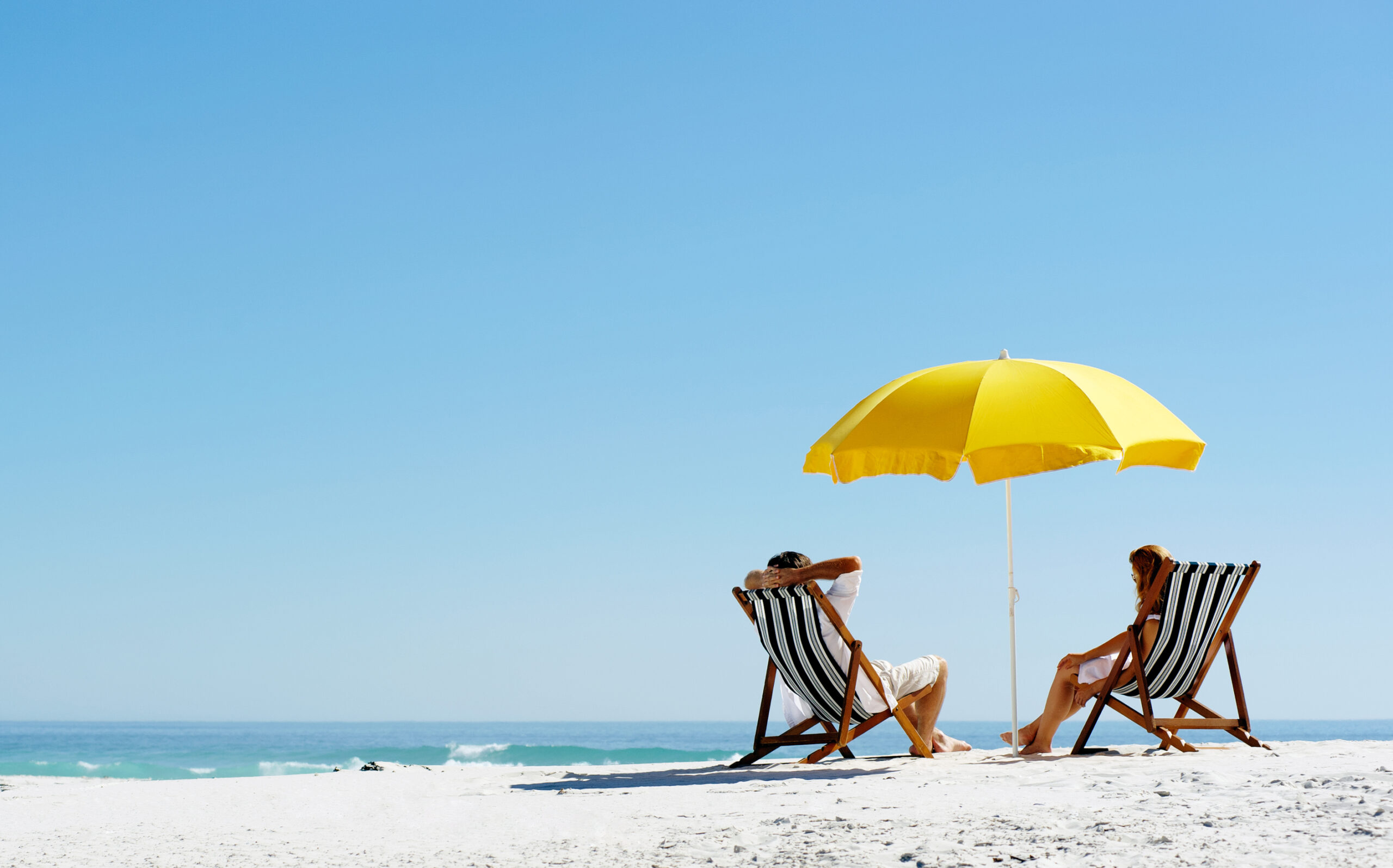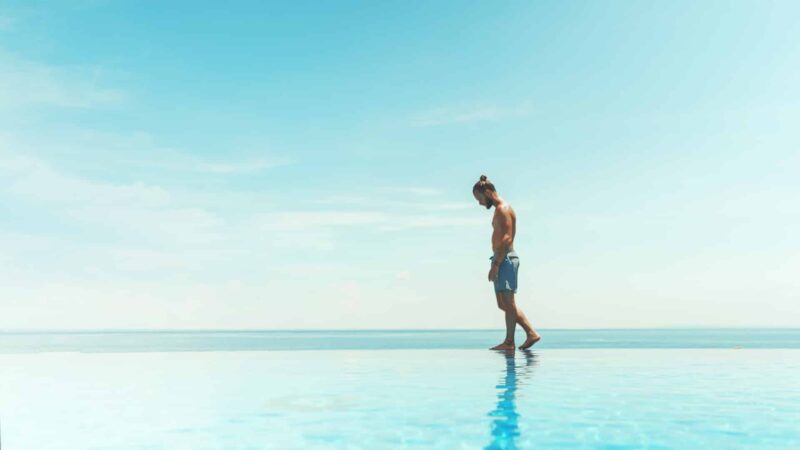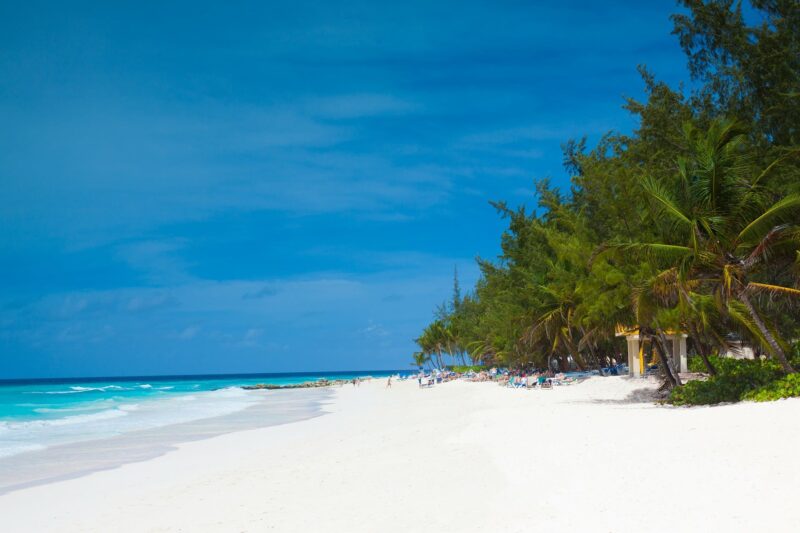In honor of National Sunscreen Day and Skin Cancer Awareness Month, Beach.com surveyed more than 1,000 Americans about their sunscreen habits, uncovering major gaps between knowledge and behavior. We then analyzed over 378 million UV dose records and melanoma skin cancer rates to identify the world’s safest and riskiest coastal spots for sun exposure.
Our research reveals that while many Americans understand the importance of sunscreen, many skip protection even though they know better. Whether you’re diligent, casual, or forgetful about sunscreen use, we’ve rounded up the best locations globally to minimize sun exposure at the beach! And for you never-sunscreeners: If applying SPF isn’t happening, you can still proactively reduce your risk by choosing a more sun-safe destination — like these top beach towns in Portugal. You should still wear sunscreen, though.
Table of Contents
- Key Findings
- Top Reasons Americans Skip Sunscreen
- Common Myths About Sunscreen
- America’s SPF Choices
- Coastal Countries with the Lowest UV Exposure and Skin Cancer Rates
- Most and Least Sun-Safe Countries for Beach Vacations
- UV Exposure and Skin Cancer Rates by Region
- Plan Your Sun-Safe Getaway with Confidence
- Sources and Methodology
Key Findings
- 78.1% of Americans do not wear sunscreen year-round.
- The average American only wears sunscreen 60% of the time they are outside.
- 64.5% of Americans rarely or never use sunscreen when it is cloudy, despite 76.6% knowing you should.
- The best countries for a sun-safe beach vacation are Latvia, Poland, Lithuania, Iceland, and Albania.
- The best U.S. states for a sun-safe beach vacation are Alaska, Washington, Maine, New Hampshire, and New York.
Top Reasons Americans Skip Sunscreen
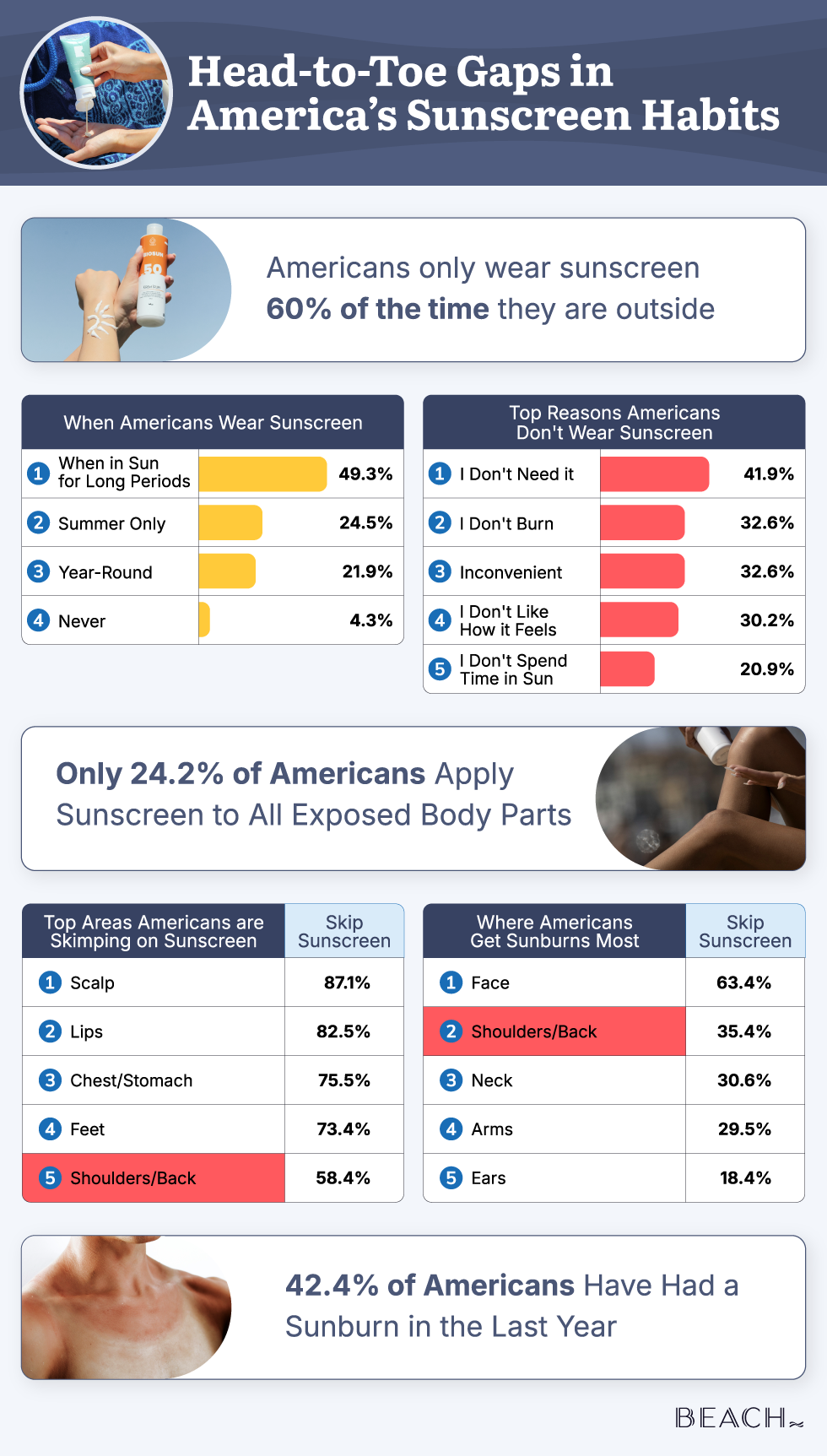
Our recent survey reveals that 78% of Americans do not wear sunscreen year-round. The largest share (49%) only wears sunscreen when in the sun for long periods. However, Americans only apply it 60% of the time when outdoors for 15 minutes or more. The consequences of this are evident in that 42% of Americans have had at least one sunburn in the past five years.
According to our survey, the primary reasons people skip sunscreen are “I don’t need it,” I don’t burn,” and perceptions that it’s “inconvenient.” Even when Americans do use sunscreen, over two-thirds (76%) do not apply it to all exposed body parts. The most commonly neglected areas are the scalp, lips, chest/stomach, feet, and shoulders/back. Unsurprisingly, these omissions somewhat correspond with the regions where people get sunburns the most: the face, shoulders/back, neck, arms, and ears.
While skipping sunscreen occasionally or skipping exposed areas can seem inconsequential, a study led by Annette Pfahlberg of the University of Erlangen-Nuremberg found that having just five sunburns in one’s life can double one’s risk for melanoma skin cancer.
Common Myths About Sunscreen
One clear takeaway about American sunscreen habits is that they’re riddled with internal contradiction. Despite 77% of Americans acknowledging the need for sunscreen on cloudy days, a whopping 65% rarely or never apply it in overcast conditions. In fact, even though we appear to know better, Americans still inaccurately link UV rays with temperature and cloud presence. This results in more burning on cooler and cloudy days because we’re not taking as many precautions.
While cloud cover does reduce some UV rays, its effects are small. Up to 90% of the sun’s rays can still penetrate your skin, according to Cancer Research UK. The risk for folks who choose not to wear sunscreen on cloudy days is almost as bad during clear-sky conditions. You absolutely can get sunburned on a cloudy day.
Over half of Americans (51%) also believe the myth that sunscreen can be waterproof. The truth is that there is no such thing as waterproof sunscreen. In 2012, the Food and Drug Administration (FDA) banned sunscreen manufacturers from using the word “waterproof” on their labels.
Sunscreen can be water resistant, but there is no such thing as waterproof sunscreen. According to the FDA, water-resistant sunscreen stays effective for 40 minutes in the water. Sunscreen can also be very water resistant, which means it remains effective for 80 minutes in the water. However, after the 40—or 80-minute mark, you must reapply.
A vast majority (73%) of Americans do not reapply sunscreen every two hours when outdoors. Only 48% said they reapply after swimming. When it comes to the question of how often to reapply sunscreen, according to Johns Hopkins, you should reapply every two hours.
This two-hour window also answers the question of how long sunscreen lasts. According to Dermatology and Skin Health, after two hours in the sun, your first application of sunscreen will be mostly absorbed or ingredients broken down, and another application is a must. This is especially true if you are swimming. Even if you’re using very water-resistant sunscreen, the longest your protection will last is about 1 hour and 20 minutes.
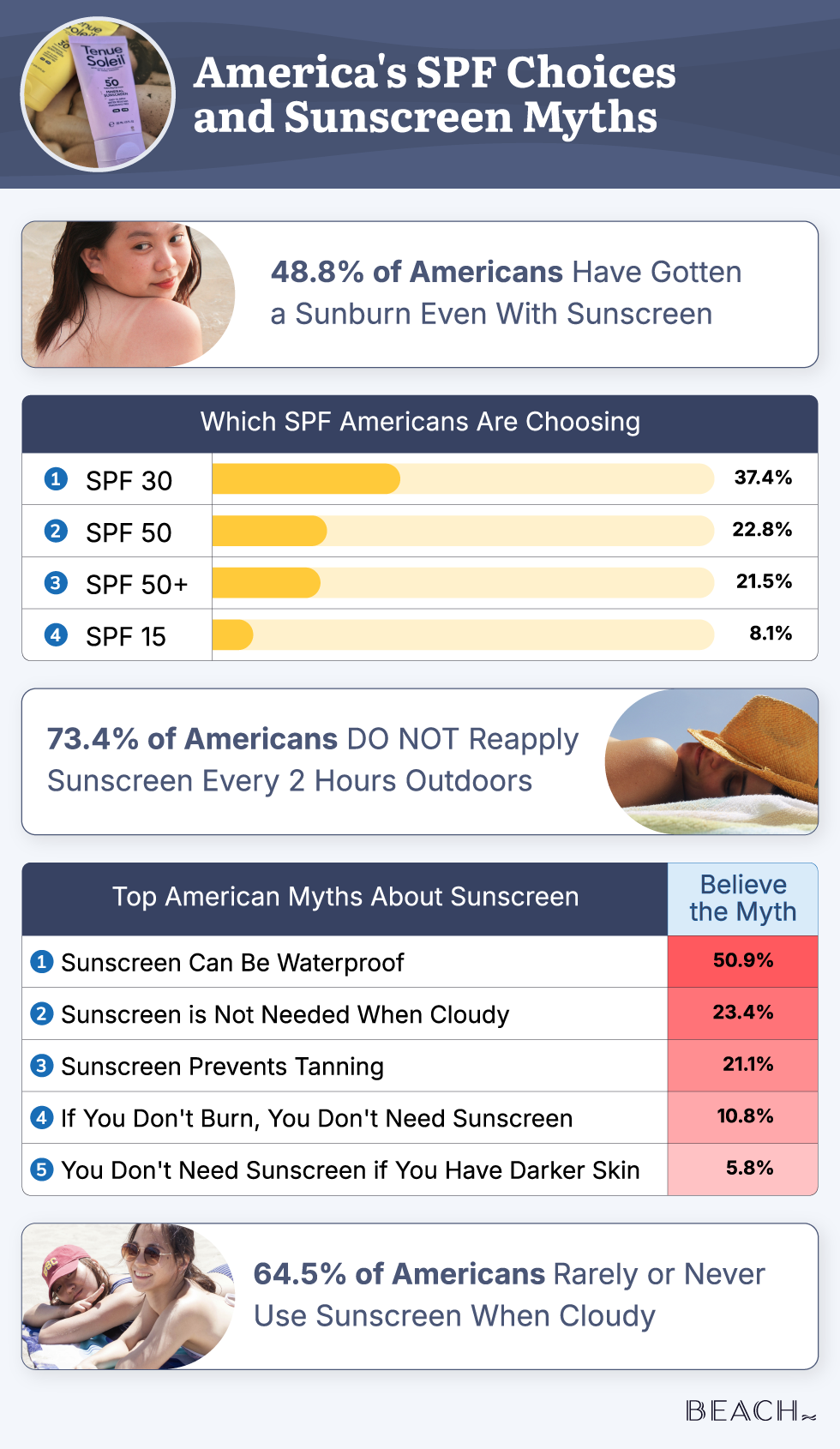
America’s SPF Choices
When it comes to SPF choices Americans are making, SPF 30 is the top choice, with just over a third (37%) opting for it. This is followed by SPF 50, which about a quarter (23%) of the population uses. Only one in five people use SPF 50+, and one in ten uses SPF 15.
Generally, SPF 30 is enough for most people as it blocks out 97% of UVB rays, according to Consumer Reports. When it comes to SPF 30 vs 50, the difference can seem small. SPF 30 allows 3% of UVB rays through, while SPF 50 allows 2%. This might seem insignificant, but as the Skin Cancer Foundation puts it, “SPF 30 is allowing 50 percent more UV radiation onto your skin.”
However, higher SPFs can create a false sense of security, leading people to skip reapplication or gloss over other protective measures like hats and seeking shade. Since 76% of Americans are not applying sunscreen to all exposed body parts, and 73% fail to reapply sunscreen every two hours, it’s not surprising that 49% of Americans say they have gotten sunburns even with sunscreen.
It’s still possible to get a sunburn even when using sunscreen correctly and as directed. However, applying it to all exposed areas, using it year-round (even on cloudy days), reapplying every two hours and after swimming, and combining it with other protective measures can significantly reduce your risk of sunburn and long-term skin damage.
Coastal Countries with the Lowest UV Exposure and Skin Cancer Rates
To help you reduce your risk of sun exposure at the beach, we analyzed over 378 million UV dose records from the European Space Agency (ESA) and melanoma skin cancer rates from the World Health Organization (WHO) for 168 countries. We found the countries where skin-damaging UV doses are low, and incidents of melanoma skin cancer are rarer. Beach.com has identified the world’s safest coastal destinations for sun exposure in our melanoma and UV radiation ranking map.
For those seeking the most sun-safe beach vacation possible, your top choices are Latvia, Poland, Lithuania, Iceland, and Albania. These nations boast the lowest combined average daily UV radiation levels and melanoma skin cancer rates, which makes them the ideal coastal destinations for travelers concerned about sun exposure. These countries average 1.76 kJ/M2 of daily UV radiation, which is far less than the global average of 4.37 kJ/M2 in our analysis. These countries also have around the global average number of skin cancer cases of 4.81 per 100,000 people.
On the other hand, if you are trying to avoid high-risk sun exposure at the beach, there are several countries where daily UV dosage and melanoma rates tend to be higher. Topping the list of the least sun-safe countries for a beach vacation are Australia, New Zealand, Papua New Guinea, Ecuador, and Peru. These countries tend to have the highest UV index, evident in their average daily UV dose of 5.4 kJ/M2 across these five countries. They also average 15.16 melanoma skin cancer cases per 100,000 people, far surpassing the global average in our analysis.
The highest UV Index ever recorded was 43.3 in Bolivia in 2003, according to a study led by Dr. Nathalie A. Cabrol of NASA Ames Research Center and the SETI Institute. This finding was a combination of environmental factors that led to this record-breaking statistic. However, Bolivia is landlocked, and we did not include it in our analysis.
While Australia and New Zealand have daily UV doses that are closer to the global average, both countries have some of the highest melanoma rates in the world. Australia has more melanoma incidents than any other nation, and New Zealand has the 4th highest rates. Denmark and Norway have higher melanoma rates than New Zealand, but far less daily UV radiation.
The country with the highest daily average UV radiation in our analysis is Ecuador. Daily doses in this country average 6.48 kJ/M2. The country with the lowest average daily UV dose is Norway at 1.06 kJ/M2. However, as mentioned before, Norway also has high melanoma incidence rates, a whopping 30.6 per 100,000 people — the third highest globally.
Norway is a cautionary tale about sun protection. With fairer skin, shorter summers, and fewer sunny days, many people take fewer precautions to protect themselves from sun damage, according to the Cancer Registry of Norway. Norway is proof that not utilizing sunscreen and other protective measures when the perceived risk seems low can actually translate to higher incidents of melanoma than in locations where the risk appears obvious.
Norway is the country equivalent of the false sense of security that the highest SPF protection gives you. Just because the risk seems lower doesn’t mean it’s gone. Traveling to a country where the UV dose is low or using the highest possible SPF sunscreen is not an excuse to be less proactive. However, traveling to a country where the UV risk is lower and using higher SPF sunscreen in tandem with attentive, proactive sun protection habits can keep your risk to a minimum.
Most and Least Sun-Safe Countries for Beach Vacations
UV Exposure and Skin Cancer Rates by Region
Latitude, or the amount of distance north or south of the equator, significantly affects UV radiation levels. That means in countries with extensive latitudinal ranges, UV dosages can vary considerably by region. Beach.com took the liberty of conducting a sub-analysis of countries with wide latitudinal spread to identify the states, provinces, and regions that offer travelers the safest beach experience with minimal sun exposure.
In the U.S., the safest coastal states with the least risk of sun exposure are Alaska, Washington, Maine, New Hampshire, and New York. The average UV dose across these states is 2.11 kJ/M2, which is marginally better than the 2.54 national average. Just like the most sun-safe countries in the world, the safest U.S. states are all the ones in the high northern latitudes. Similarly, the least safe states are in the southernmost parts of the U.S. Those states are Hawaii, Florida, Texas, Louisiana, and Georgia, which average 4 kJ/M2 each day.
In Mexico, the safest beachside states for a sun-safe coastal escape are Baja California, Sonora, Baja California Sur, Yucatán, and Quintana Roo. These states usually see about 4.37 kJ/M2 of UV radiation daily. With an average dose of 5.28 kJ/M2, the least sun-safe states are Oaxaca, Chiapas, Jalisco, Tabasco, and Campeche. Baja California is the only Mexican state where average daily UV radiation (3.86 kJ/M2) is lower than that of Florida (3.98 kJ/M2), the U.S. mainland state with the highest UV exposure.
Click to expand the UV map of Mexico:
In China, the least sun-safe province gets over twice the average daily UV dosage as the safest province. Liaoning province, the safest, gets 2.54 kJ/M2 daily radiation on average, while Hainan province, the least safe, gets 5.12 kJ/M2. The other top four safest provinces are Tianjin, Hebei, Shandong, and Jiangsu. The other four least sun-safe provinces are Guangdong, Guangxi, Fujian, and Zhejiang.
Click to expand the UV map of China:
India doesn’t have as much latitudinal spread as China, but it still experiences some daily variability in UV dosages between its northern and southern points. The Indian states most sun-safe for a beach vacation are Gujarat, the union territory of Dadra and Nagar Haveli and Daman and Diu, Maharashtra, Andhra Pradesh, and Goa. Average daily UV radiation across these states is 5.12 kJ/M2. The least safe states are Kerala, Tamil Nadu, Andaman and Nicobar, Puducherry, and Karnataka, which together average 5.65 kJ/M2.
Click to expand the UV map of India:
While Australia as a whole is one of the least safe countries for sun exposure at the beach, Australia, like China, has extreme variability in average daily UV doses. This means that some Australian destinations aren’t as extreme as the national average. With a daily UV dose averaging 3.42 kJ/M2, Tasmania, Victoria, and New South Wales are among the top states for the most sun-safe beach vacations in Australia.
The #1 safest area in Australia for sun exposure is the extremely remote Macquarie Island, part of the Tasmanian State Reserve. While getting there can be a challenge, and access is somewhat restricted, it is the safest Australian destination for minimizing sun exposure. At a daily UV dose average of 1.89 kJ/M2, its daily exposure is more on par with Germany or Poland. This is because the island sits much further south of the Australian mainland.
Destinations you are better off avoiding in Australia if skin damage is of utmost concern are the Northern Territory, Queensland, Western Australia and South Australia. With an average daily UV dose of 4.83 kJ/M2, these are the states that contribute most to the country’s high UV dosage average, helping make the country one of the least sun-safe destinations overall.
Click to expand the UV map of Australia:
Argentina only has five provinces and one autonomous district with coastal access. While its daily UV dose averages vary from north to south, it doesn’t have as wide of extremes as some other countries, like China or Australia. Your best bet for minimizing sun exposure in this country is to visit Tierra del Guego, Santa Cruz, or Chubut, where daily UV doses average 2.49 kJ/M. Provinces you are better off avoiding are the autonomous district Ciudad de Buenos Aires, and the provinces of Buenos Aires and Río Negro that see an average UV dose of 3.49 kJ/M2 daily.
Click to expand the UV map of Argentina:
Chile experiences some of the greatest variability in daily UV doses of any country in our analysis. Its most sun-safe region, Magallanes y Antártica Chilena, averages 2.26 kJ/M2 per day while its least sun-safe region, Arica y Parinacota, averages 6.44 kJ/M2. Other top regions for minimizing exposure include Aisén del General Carlos Ibáñez del Campo, Los Lagos, Los Ríos, and La Araucanía. Other regions to avoid to reduce sun damage include Tarapacá, Antofagasta, Atacama, and Coquimbo.
Click to expand the UV map of Chile:
Plan Your Sun-Safe Getaway with Confidence
At Beach.com, we’re concerned about the preservation and protection of two things: your health and our shores. While we proactively research and provide you with the best information possible to help you make the healthiest travel choices, we also organize beach cleanups to promote environmental sustainability.
If you’re here, you know protecting your health matters, and you likely also know that protecting the health of our shores matters. If you’re as passionate about the health of our planet as you are about the health of your body, join us as a Cleanup Captain and help lead a local cleanup effort in your community!
Sources and Methodology
Sun-Safe Index: Our 10-point sun-safe index normalizes daily UV doses and melanoma data with equal 50:50 weighting. A rank of 10 is the least safe, and 0 is the safest. We filtered out countries, states, provinces, or regions that have a Level 4: Do Not Travel Advisory from the U.S. Department of State as of April 23, 2025. Only countries, states, provinces, or regions that have a coastal beach (non-inland water) were included in our analysis.
Many countries have wide latitudinal ranges, resulting in significant daily variations in UV dose between their northern and southern points. To improve our reporting, we created sun-safe indices at the state, provincial, or regional level for a select group of countries with the most significant variability. While this sub-analysis is not exhaustive of countries with variable UV data between northern and southern border points, these countries are the most affected by this variability.
UV Dose: We analyzed over 378 million records of daily UV dose data for the entire year of 2022, sourced from the Tropospheric Emission Monitoring Internet Service (TEMIS), provided by the European Space Agency (ESA). We utilized the daily clear-sky erythemal UV dose netCDF file from the Multi-Sensor Reanalysis (MSR-2) archive, which provides the cumulative amount of skin-damaging UV radiation for each day over approximately 1 million coordinate pairs on a global grid.
It is essential to note that UV dose (also known as UV radiation dose) data differs from UV Index data. Daily dose data is cumulative, while the UV Index is instantaneous. UV dose data is expressed in kilojoules per square meter, while the UV Index is unitless. While UV indices are great for public health messaging, UV dose data is more scientifically comparable across regions and ideal for correlating with skin cancer data.
We averaged UV dose data by coordinate pairs. Then, using large-scale (1:10m) Natural Earth cultural vectors, we geospatially mapped coordinate pairs, joining them to country polygons. Once we mapped all points to countries, we calculated the national average UV dose levels for each country based on all mapped grid points within its boundaries. We analyzed 168 countries before further filtering out countries without coastal beaches and those with Level 4 travel advisories from the U.S. State Department.
Many countries span latitudinal ranges that result in a wide variety of UV levels between their northern and southern borders. To improve our reporting, we employed the same method to map coordinate pairs of UV data at the state, regional, or provincial level for the following countries: the United States of America, Australia, China, India, Mexico, Argentina, and Chile.
Melanoma Skin Cancer Rates: We utilized cancer data from the International Agency for Research on Cancer (IARC), a part of the World Health Organization (WHO), to enhance our analysis. We collected incidence data on the age-standardized rate (ASR) for skin melanoma for both sexes by country for 2022.
ASR data is a standardized rate that differs from the crude rate of skin melanoma. Age majorly influences the risk of cancer, and standardization is required when comparing rates across countries. ASR is a weighted mean of the age-specific rates, with weights based on the population distribution of a standard population. In this case, we used the World (W) rate standard. ASR rates are expressed per 100,000 persons, meaning an ASR of 5 translates to 5 incidents of skin melanoma per 100,000 people in a given country.
Sunscreen Survey: We conducted a survey of 1,003 Americans on April 17, 2025, regarding their sunscreen habits, including how often and where they use it, as well as the reasons why they do not use it. We also had respondents select statements about sunscreen use that they believe are true. Respondents ranged in age from 18 to 77 years old, with 49% female, 50% male, and 1% non-binary representation.
Fair use
When using this data and research, please attribute by linking to this study and citing Beach.com.

